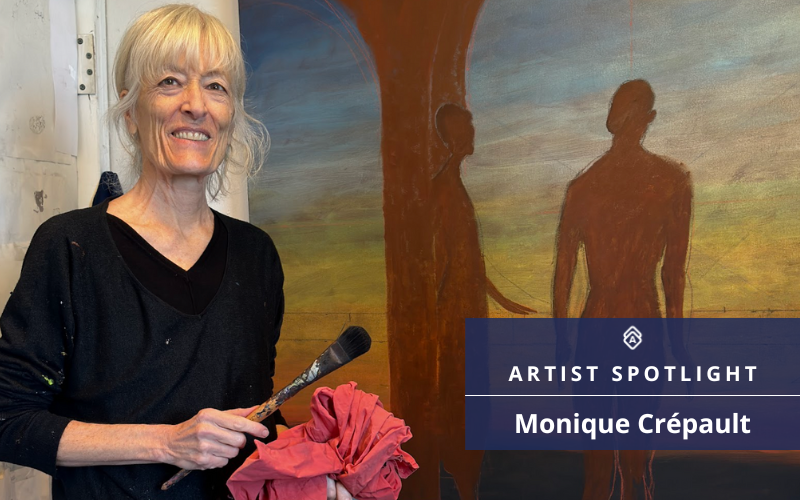Monique Crépault's work offers a window into new perspectives and unexplored possibilities, challenging the traditional gaze and embracing a balance of color, light, and form.
Artwork Archive's Featured Artist Monique Crépault (aka: MŌ), invites viewers to reconsider their perspectives through her bold, contemporary figurative style.
Based in Montreal, Quebec, MŌ draws on her background in visual arts and scenography to create paintings where theatricality takes center stage.
The nude is the cornerstone of her art, used “like a director uses actors” to craft atmospheres and tell open-ended stories. Her paintings often surprise viewers, especially those featuring naked men, a subject rarely explored by women in art history. As MŌ explains, “Artists have always been fascinated by the human body, but male painters have long painted women without the reverse being true.”
Through mirrors, frames, and windows, her theatrical compositions reflect parallel worlds, coexistence, and infinite imagination.
Artwork Archive had the chance to chat with MŌ about her creative process, her exploration of painting male nudes, and how Artwork Archive helps her manage her art career.
You can see more of her work on Discovery and learn more about her art practice below:
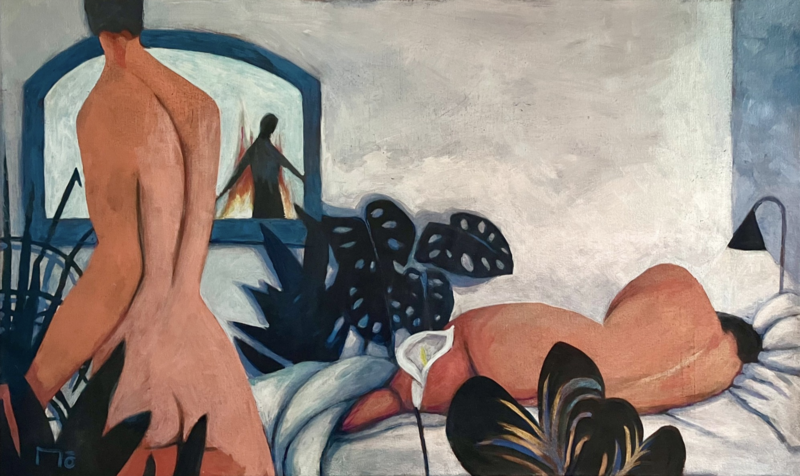 MŌ, Pendant queue tu dors, 24 x 40 in
MŌ, Pendant queue tu dors, 24 x 40 in
Can you walk us through your creative process?
My creative process begins with preliminary sketches on my iPad, where I map out the composition, colors, and characters. Meanwhile, in my studio, I stretch and prepare my canvases with a layer of burnt or natural sienna—earth tones that remind me we are made of dust and water.
I enjoy starting a painting, when the canvas holds all possibilities.
I also enjoy the process of searching for a particular story. As the process unfolds, my paintings often end up very different from the initial sketches. I sand and scrape almost as much as I paint, with characters and elements disappearing or emerging suddenly until everything fits.
Only when the painting is completed do I find its title.
Can you elaborate on how theatricality shapes your compositions?
I love telling stories. I studied set design, which influenced the way I paint. A scene changes according to the light, the details added, and the composition of the spaces.
I often begin a painting by adding one or a couple of characters. They inspire a new story. A character may disappear at the end of the painting, but it will have been the initiator. This character brings his own light and composition, which is what I aim to depict.
Intimacy is a recurring theme in my paintings. This year, I’ve primarily painted skies. Characters, animals, and birds occupy these spaces, along with simple arches. These serve as metaphors for the beauty humankind can create.
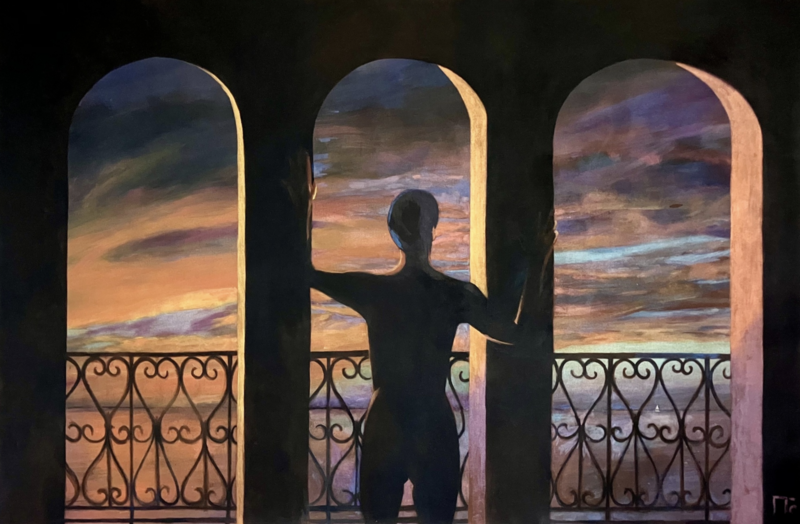 MŌ, La Grande Bellezza, 40 x 60 in
MŌ, La Grande Bellezza, 40 x 60 in
What are your thoughts regarding the art historical tradition of male painters depicting nude women, and how does your work offer a fresh perspective by reversing that dynamic?
Since my very first nude drawings more than fifty years ago, I have always loved drawing, sculpting, and painting the human body, which remains a constant source of wonder.
I am also an ardent feminist. The contribution of women in art (as in life in general) is a subject that has always fascinated me.
I’ve been asked numerous time to explain why I paint naked men, and my answer is very simple.
Men have painted naked women for centuries, and we never asked them why. My paintings are windows to new perspectives.
In hindsight, what’s something you wish you knew before becoming a professional artist?
I wish I had known the importance of marketing, as it has become a big part of being an artist nowadays.
I believe in anonymity and naively wish that art would not sell because of who painted it, but for its own sake.
In the 90s, I created installations of clay sculptures of human bodies in nature and was involved in the earth art movement. I was drawn to this field because it wasn’t commercially inclined.
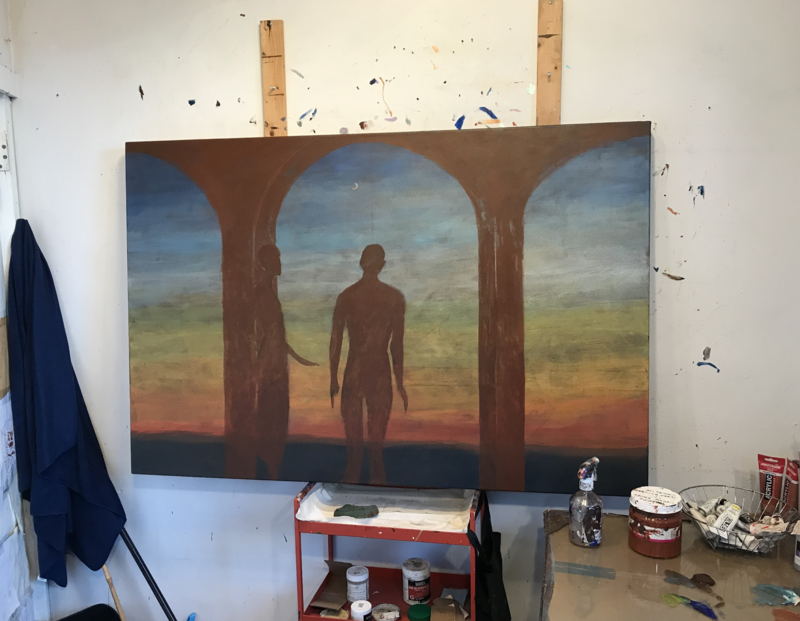
A look inside MŌ's studio and an unfinished version of her painting, Paradise Lost, 40 x 60 in
What do you think is the most misunderstood aspect of being a professional artist?
The most misunderstood aspect of being a professional artist is the solitude required to create art.
The long hours of solitude are not suited for everyone, but I believe they are essential. You have to be in your studio every day, whether you feel like it or not. It’s the only way to keep doing it.
If you wait for inspiration, it will go somewhere else.
Can you tell us why you decided on Artwork Archive to help manage your art career?
I chose Artwork Archive because my partner, who is also a painter, recommended it to me.
I immediately liked the platform because it's user-friendly and operates like my internal computer.
Aside from the basic and essential functions of Artwork Archive (like inventorying of everything I create so I can easily track prices, sales, dimensions, locations, and titles), I really appreciate the Private Rooms feature.
This feature allows me to present available paintings to gallery owners or customers. It’s like a small exhibition room where I can visualize all the works in a single series.
Impress Everyone With Private Rooms:
Artwork Archive's Private Rooms let you create tailored and professional online viewing rooms of selected artwork.
Showcase your work by series, share availability, and elevate how you present your art. You can even invite your recipients to favorite the pieces they love, and leave comments.
What advice would you give an artist who’s just starting out in their professional career?
Trust yourself. There are many tangents and possible routes for creation.
I believe you have to remain honest with yourself as much as possible, even if it means making mistakes and starting over.
Art is a reflection of life, and life is an eternal whirlwind of doubts, achievements, and failures—but also of joy and ecstasy. Art allows us to communicate all of it.
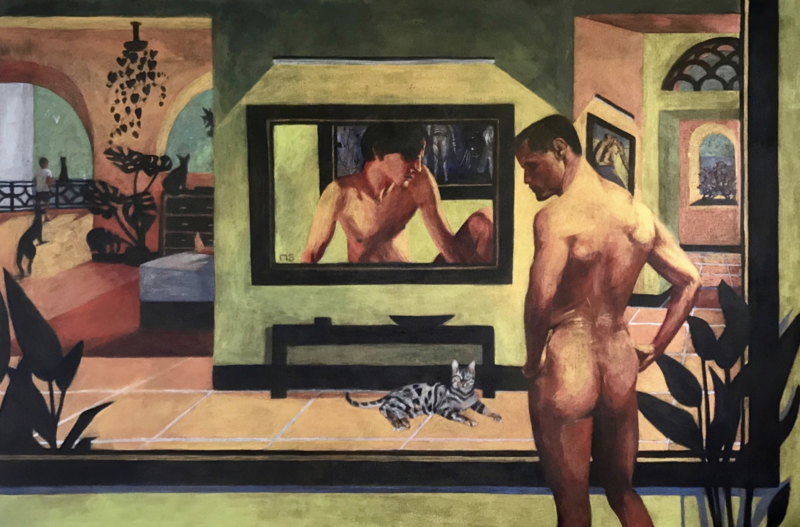 MŌ, Loft Story, 40 x 60 in
MŌ, Loft Story, 40 x 60 in
Monique Crépault uses Artwork Archive to professionalize her practice, manage her inventory, showcase her work, and a lot more.
You can make an online portfolio, catalog your artwork, and generate reports like inventory reports, tear sheets, and invoices in seconds with Artwork Archive. Take a look at Artwork Archive's free trial and start growing your art business.
